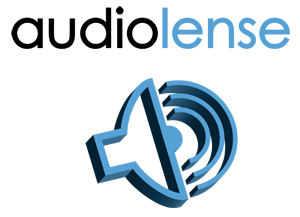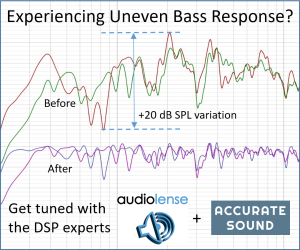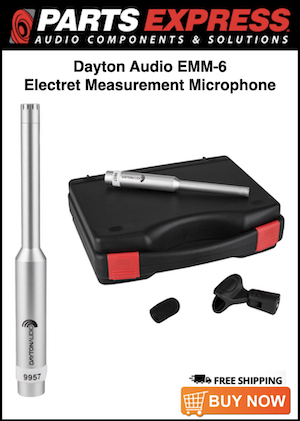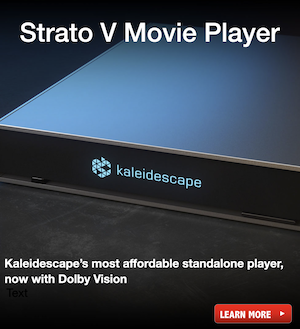Ofer
Member
Thread Starter
- Joined
- Mar 15, 2021
- Posts
- 269
More
- Preamp, Processor or Receiver
- miniDSP 4x10hd
- Main Amp
- Emotiva XPR200 midrange amp
- Additional Amp
- Crest audio 2001A bass amp, Crest audio 8002 sub
- Other Amp
- Rotel RA930ax twitter amp
- DAC
- RME UC
- Computer Audio
- Sony Bravia android TV
- Universal / Blu-ray / CD Player
- Marantz original 5E CD
- Streaming Subscriptions
- Deezer HiFi
- Front Speakers
- Andromeda MkII
- Subwoofers
- 18" OEM powered subwoofer, 18" Martycube Dayton A.
- Screen
- Sony bravia 65XF9005
- Other Equipment
- HP i5 running W10, HLC convolver for Audio Lense filters
Prolog
I have been using active crossover for about 10 years now. Most of the time the computer was the media source, Kodi and Foobar2000, and Ashly crossovers (analog and then digital) before the amps. The last 2 years my smart TV became the media source, as my computer died, using miniDSP as crossover and preamp. This was a very family friendly setup, yet the ~10 filters/channel provided by the miniDSP is hardly state of the art DRC. By moving to AL the hope was to have the computer as a DSP/DRC box and continue to stream from the TV. ALL my music files are CD rips so 44.1/16 streaming was just fine. I dedicated an i5 9th generation computer with 2 ~3ghz cores 16gb ram and bought a RME FF400, a bit old but still considered very high quality and stable audio interface. From then on everything went wrong. First despite the fact that streamers, including some high end music ones, were around for quite a while now it seems that most AL users still use the computer as their media source. The RME would not play with JRiver Asio line in function and AL standalone convolver did could not take the asio (SPDIF) in and send to the outputs. You could dive in the links below. The closest I could get it all to work with external input and computer convolution was with Elements/Plogue Bidule and X-MCFX convolver. But that had it issues too. The only setup that really works for me now is with HLC.
 www.avnirvana.com
www.avnirvana.com
 www.avnirvana.com
www.avnirvana.com
 www.avnirvana.com
www.avnirvana.com
 www.avnirvana.com
www.avnirvana.com
Setup
Mitch help file is extensive. I will go over pointers that were relevant to me on W10 and 3way stereo with sub. After installation of the convolver and VB-cable you choose VB-cable as your default input and output in windows sound this is for playing/streaming from the PC. For ASIO playback you open the convolver and choose options >audio settings>Asio.

In my case I have left only the SPDIF input active and analog outputs 1-8. It is important that the sample rate in the audio interface match that of the convolver. In my system buffer size below 512 caused issues and hence I set it at 1024. In the interface I chose the SPDIF clock, clock issues cause cracks and pops so do low buffers. Beware of the test button it sends a very loud beep, don’t use it! You will get an input and output strips, in between right click on the empty space and add the HLC convolver. For stereo active choose the number of channels you need. In my case it was 8 so 7.1 or octagonal. What you get should look like this. I know it says 6.1 this is before the final setup.

From here it is similar to Elements and X-MCFX you pull wires from the inputs to the convolver and from there to the outputs. Notice that the outputs (upon touching with the cursor) will read LF, LR, C etc. and not analog 1,2 etc. Disregard this it doesn’t matter. In the end it will look like this:

That’s it you are ready to load filters. When creating filters use a flat folder architecture, nothing deeper then one folder otherwise HLC gets confused so C//Filters> minimum delay. In the folder have all the sample rate filter you thing you might need HLC will automatically change sample rates. In the filter module use the magnifying glass and add cfg. Files to each slot. I used pink noise and the bars on the right to trim the gain of each filter but the best way is with SPL meter. Each set of filterbanks can be saved but the audio settings are not saved. So if you saved a filter bank in windows audio settings and are now in ASIO setting it will not revert to windows audio.
I did configure windows audio as well and will answer any questions but I fill that many other users have done so as well.
Usage
Once clock issues and buffers are set this software is very stable. It is by far the best option for my scenario. Once you set the gain for each filter it is very easy to just switch filter with the mouse. The switch is seamless. It is very educational for us AL users to really hear the difference in real-time. I have created a crossover only filter i.e. partial correction from 0hz. The difference from crossover only to FR only is huge, my room is very vibrant Topt ~700ms. TTD is audible but not as huge. Loading 6 TTD filters can really help understand how different step responses sound.

Final words
The move to AL and computer DSP was not easy in my case and neither cheap. HLC is not a cheap software but IMO but it is gives the best overall solution by far. Only now can I enjoy the high quality that state of the art DRC has to offer without endless tweaking with audio settings and praying for it to work. I would like to thank @Mitchco for his assistance along beyond just setups, also to @hulkss , @Omid @mccarty350 @juicehifi and all the great community that tried to help along the way.
I have been using active crossover for about 10 years now. Most of the time the computer was the media source, Kodi and Foobar2000, and Ashly crossovers (analog and then digital) before the amps. The last 2 years my smart TV became the media source, as my computer died, using miniDSP as crossover and preamp. This was a very family friendly setup, yet the ~10 filters/channel provided by the miniDSP is hardly state of the art DRC. By moving to AL the hope was to have the computer as a DSP/DRC box and continue to stream from the TV. ALL my music files are CD rips so 44.1/16 streaming was just fine. I dedicated an i5 9th generation computer with 2 ~3ghz cores 16gb ram and bought a RME FF400, a bit old but still considered very high quality and stable audio interface. From then on everything went wrong. First despite the fact that streamers, including some high end music ones, were around for quite a while now it seems that most AL users still use the computer as their media source. The RME would not play with JRiver Asio line in function and AL standalone convolver did could not take the asio (SPDIF) in and send to the outputs. You could dive in the links below. The closest I could get it all to work with external input and computer convolution was with Elements/Plogue Bidule and X-MCFX convolver. But that had it issues too. The only setup that really works for me now is with HLC.
Playing external spdif source in RME FF400 through convolver alternative method
To all that didn't follow the previous episodes, in short I want to use my computer as a DSP box to convolve external signal from my TV. Sounds simple any pro-logic AVR can change inputs and run DSP. Well in computer DSP there are endless options and that means endless ways to go wrong. See...
Using JRiver convolver for external sources
Hi everyone, My attempts to use AL standalone convolver for playing external spdif source have been futile (see my post baby steps with AL). I was wondering if there is anyone who tried using JRiver convoler with an external source pluged to the soundcard? preferably with an RME card.
Sample rate locked at 48khz
After all kinds of trials and many errors the only option that worked for inputing external spdif source through a convolver was using the listen in option. https://www.avnirvana.com/threads/using-jriver-convolver-for-external-sources.10797/ In short, in the recording tab I chose the spdif as...
Configuring RME TotalMix to work with AL convolver
For the last 2 weeks I have been trying to setup my computer DSP rig for 3way crossover with sub using AL convolver (see my baby steps in AL post). I works with Asio Bridge and AL convolver but for standalone and external spdif source it is still a no go. The external source is not routed to the...
Setup
Mitch help file is extensive. I will go over pointers that were relevant to me on W10 and 3way stereo with sub. After installation of the convolver and VB-cable you choose VB-cable as your default input and output in windows sound this is for playing/streaming from the PC. For ASIO playback you open the convolver and choose options >audio settings>Asio.
In my case I have left only the SPDIF input active and analog outputs 1-8. It is important that the sample rate in the audio interface match that of the convolver. In my system buffer size below 512 caused issues and hence I set it at 1024. In the interface I chose the SPDIF clock, clock issues cause cracks and pops so do low buffers. Beware of the test button it sends a very loud beep, don’t use it! You will get an input and output strips, in between right click on the empty space and add the HLC convolver. For stereo active choose the number of channels you need. In my case it was 8 so 7.1 or octagonal. What you get should look like this. I know it says 6.1 this is before the final setup.
From here it is similar to Elements and X-MCFX you pull wires from the inputs to the convolver and from there to the outputs. Notice that the outputs (upon touching with the cursor) will read LF, LR, C etc. and not analog 1,2 etc. Disregard this it doesn’t matter. In the end it will look like this:
That’s it you are ready to load filters. When creating filters use a flat folder architecture, nothing deeper then one folder otherwise HLC gets confused so C//Filters> minimum delay. In the folder have all the sample rate filter you thing you might need HLC will automatically change sample rates. In the filter module use the magnifying glass and add cfg. Files to each slot. I used pink noise and the bars on the right to trim the gain of each filter but the best way is with SPL meter. Each set of filterbanks can be saved but the audio settings are not saved. So if you saved a filter bank in windows audio settings and are now in ASIO setting it will not revert to windows audio.
I did configure windows audio as well and will answer any questions but I fill that many other users have done so as well.
Usage
Once clock issues and buffers are set this software is very stable. It is by far the best option for my scenario. Once you set the gain for each filter it is very easy to just switch filter with the mouse. The switch is seamless. It is very educational for us AL users to really hear the difference in real-time. I have created a crossover only filter i.e. partial correction from 0hz. The difference from crossover only to FR only is huge, my room is very vibrant Topt ~700ms. TTD is audible but not as huge. Loading 6 TTD filters can really help understand how different step responses sound.
Final words
The move to AL and computer DSP was not easy in my case and neither cheap. HLC is not a cheap software but IMO but it is gives the best overall solution by far. Only now can I enjoy the high quality that state of the art DRC has to offer without endless tweaking with audio settings and praying for it to work. I would like to thank @Mitchco for his assistance along beyond just setups, also to @hulkss , @Omid @mccarty350 @juicehifi and all the great community that tried to help along the way.

















